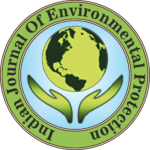IJEP 42(4): 457-463 : Vol. 42 Issue. 4 (April 2022)
Pratap Kumar Swain and Trinath Biswal*
Veer Surendra Sai (VSS), University of Technology, Department of Chemistry, Burla- 768 018, Odisha, India
Abstract
In this work, we developed brick by using the granulated blast furnace (BF) slag produced from the Rourkela Steel Plant with lime and sand. Two types of bricks are developed; one is the mixture of granulated BF-slag and lime whereas the other one is a mixture of granulated BF slag, sand and lime. The volume and weight were measured and the bricks were characterized by compressive strength, water absorption capacity and efflorescence testing. From the experiments and analyzed data, it was found that for M-4 sample of lime-slag brick having composition of 20% lime and 80% slag, the compressive strength is the maximum and water absorption (%) is minimum, whereas in the case of lime-sand-slag brick the compressive strength is the maximum at M-6 sample having composition 30% lime, 30% slag and 40% sand whereas water absorption is minimum at M-4 sample having composition 20% lime, 20% slag and 60% sand. The efflorescence test shows that no soluble salts were dispersed over the tested brick indicating a high quality of brick relative to conventional bricks. Hence, from the analyzed data, we conclude that the brick developed with 20% lime and 80% slag is better in quality than the conventionally manufactured bricks.
Keywords
Blast furnace slag, Water absorption capacity, Compressive strength, Eco-utilization
References
- Foti, D., et al. 2019. Mechanical characteristics and water absorption properties of blast-furnace slag concretes with flyashes or microsilica additions. Appl. Sci., 9(7): 1279-1292.
- Surul, O., et al. 2020. Recycle of ground granulated blast furnace slag and flyash on eco-friendly brick production. European J. Env. Civil Eng., 1-19.
- Oge, M., et al. 2019. An overview of utilization of blast furnace and steel making slag in various applications. Mater. Today. 11: 516-525.
- Singh, G., et al. 2015. Study of granulated blast furnace slag as fine aggregates in concrete for sustainable infrastructure. Social Behavioural Sci., 195: 2272-2279.
- Yi, H., et al. 2012. An overview of utilization of steel slag. Env. Sci., 16: 791-801.
- Shubhi, D., et al. 2019. Utilization of iron and steel slag in building construction. AIP Conference Proceedings. pp 2158-2165.
- Elibol, C. and O. Sengul. 2016. Effects of activator properties and ferrochrome slag aggregates on the properties of alkali-activated blast furnace slag mortars. Arabian J. Sci. Eng., 41: 1561-1571.
- Liu, G., et al. 2019. Characterization and performance of high volume recycled waste glass and ground granulated blast furnace slag or flyash blended mortars. J. Cleaner Prod., 235: 461-472.
- Georgakopoulos, E., et al. 2017. Two-way valorization of blast furnace slag: Synthesis of precipitated calcium carbonate and zeolitic heavy metal adsorbent. J. Visualized Expt., 120: 1-17.
- Senani, M., et al. 2018. Eco-concrete with incorporation of blast furnace slag as natural aggregates replacement. Sci. Tech. Mater., 33(3): 144-150.
- Shmiyarlagadda, V. and M. Beulah. 2016. Utilization of ground granulated blast furnace slag and pulverized flyash in the manufacture of stabilized mud blocks. Int. J. Earth Sci. Eng., 9(3): 46-53.
- Swain, P.K., et al. 2018. Recycling and utilization of solid waste generated in the Rourkela Steel Plant, Odisha. J. Ind. Poll. Cont., 34(2): 2080-2087.
- Swain, P.K., et al. 2018. Physico chemical and mineralogical properties of flyash of Rourkela Steel Plant, Odisha and its eco-utilization. Poll. Res., 38(2): 400-408.
- Sasmita, C., et al. 2016. A comparative study of physico-chemical and mineralogical properties of LD slag from some selected steel plants in India. J. Env. Sci. Tech., 9: 75-87.
- Shih, P.H., et al. 2004. Characteristics of bricks made from waste steel slag. Waste Manage., 24(10): 1043-1047.
- Shin, H.O., et al. 2016. Mix design of concrete for prestressed concrete sleepers using blast furnace slag and steel fibers. Cement Concrete Composites. 7: 39-53.
- IS 455. 1989. Portland slag cement – Specification [CED 2: Cement and concrete]. Indian Standards, New Delhi.
- Yuan-Dong, P., et al. 2017. Sintering of solid waste generated in iron and steel manufacturing process in Shougang Jingtang. J. Iron Steel Res. Int., 24(7): 697-704.
- Apithanyasai, S., et al. 2020. The potential of industrial waste: Using foundry sand with flyash and electric arc furnace slag for geopolymer brick production. Heliyon. 6(3): 1-11.
- IS 15658. 2006. Precast concrete blocks for paving – [CED 5: Flooring, wall finishing and roofing]. Indian Standards, New Delhi.
- Ghosh, A., et al. 2018. Reuse of fly ash and bottom ash in mortars with improved thermal conductivity performance for buildings. Heliyon. 4(11): 1-31.
- IS 3495-1 to 4. 1992. Methods of tests of burnt clay building bricks. Part 1: Determination of compressive strength. Part 2: Determination of water absorption. Part 3: Determination of efflorescence. Part 4: Determination of warpage [CED 30: Clay and stabilized soil products for construction]. Indian Standards, New Delhi.
- Kejkar, R.B., et al. 2020. Performance evaluation of cost-effective non-autoclaved aerated geopolymer (NAAG) blocks. Arabian J. Sci. Eng., 1-13.
- Ghanmi, K.A., et al. 2016. A review on the durability of alkali-activated flyash/slag systems: Advances, issues and perspectives. Ind. Eng. Chem. Res., 55(19): 5439-5453.
